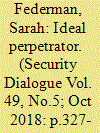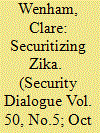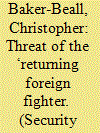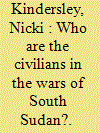|
|
|
Sort Order |
|
|
|
Items / Page
|
|
|
|
|
|
|
| Srl | Item |
| 1 |
ID:
168495


|
|
|
|
|
| Summary/Abstract |
This article examines Turkey’s authoritarian state surveillance regime by developing the concept of the authoritarian surveillant assemblage (ASA), building on and expanding the concept of the surveillant assemblage (SA). Turkey’s ASA is the outcome of diverse surveillance systems, which continuously expand their reach, form new connections and incorporate new actors. These systems include a protest and dissent surveillance system, an internet surveillance system, a synoptic media surveillance system and an informant–collaborator surveillance system. Turkey’s ASA is controlled by the Turkish state and serves its repressive interests. Although pivotal in emphasizing the complexity of surveillance connections and increasing diversification of and collaboration among surveillance actors, the SA model of surveillance puts the main emphasis on decentralized, uncoordinated and multifaceted forms of surveillance, and does not offer sufficient analytical space to understand how an authoritarian state could coordinate diverse surveillance systems and use it for the overarching purpose of control. The article draws on Michael Mann’s theory of state power and the authoritarian state to address these limitations of the SA and conceptualize the ASA. It shows how the diverse systems of Turkey’s ASA work in concert with one another under the hierarchical command of Erdoğan’s Justice and Development Party (AKP) to control the population and suppress dissent.
|
|
|
|
|
|
|
|
|
|
|
|
|
|
|
|
| 2 |
ID:
161491


|
|
|
|
|
| Summary/Abstract |
Mass atrocity requires the participation of numerous individuals and groups, yet only a few find themselves held accountable. How are these few selected? This article offers a framework that is useful for understanding how the condemned often embody attributes that keep them in the spotlight. Because norms used to identify perpetrators can set the context for future violence, long-term security requires interrupting both the actions of perpetrators and the discourses about them. A form of praxis, this study of the contemporary conflict over the French National Railways’ (SNCF) amends-making for its World War II transport of deportees towards death camps considers how certain perpetrators come to stand for the many. The SNCF remains in the spotlight not because of greater culpability or an unwillingness to make amends but because it embodies attributes of an ‘ideal’ perpetrator: it is (1) strong, (2) abstractable, (3) representative of the nature of the crime, and (4) has a champion-opponent who focuses attention on the perpetrator. Understanding the labeling process makes visible who and what we ignore at our own peril.
|
|
|
|
|
|
|
|
|
|
|
|
|
|
|
|
| 3 |
ID:
168492


|
|
|
|
|
| Summary/Abstract |
Brazil’s Zika virus crisis (2015–17), following hot on the heels of the Ebola outbreak (2014–15), dominated newsfeeds and high-level discussions amid governments, the UN system and beyond, with emerging fears relating to Congenital Zika Syndrome (CZS), embodied by microcephaly. However, beyond the ensuing panic in Latin America facing a generation of Zika babies, the outbreak demonstrates key developments in our understanding of the interaction between health and security, based on the Copenhagen School’s securitization approach. It suggests that unlike previous diseases that were securitized, it was not the virus that was the cause of the security threat, nor how many people were affected, but a combined concern over where (in Brazil at a time of domestic political crisis), when (immediately post-Ebola), who (foetuses and babies), how (unknown disease characteristics) and what was the existential threat (the vectorized unknown). This article shows these developments for global health security through empirical analysis of the multiple securitization processes that occurred within Brazil for the Zika virus, at the subnational and federal levels.
|
|
|
|
|
|
|
|
|
|
|
|
|
|
|
|
| 4 |
ID:
168493


|
|
|
|
|
| Summary/Abstract |
This article analyses a mid-20th century computerized pacification reporting system, the Hamlet Evaluation System (HES), used by the US military to measure hamlet-level security and development trends in the Vietnam War. The significance of the HES was its capacity to translate US Military Advisor observations of Vietnamese hamlet life into a machine-readable format used by US military systems analysts to disclose ‘patterns of life.’ I show how US Military Advisors operated as ‘embodied sensors’ within the HES, producing a distinctive location-based event ontology – a ‘view of below’ – accompanied by rudimentary digital maps in-formation from incoming hamlet-level observation streams. I argue that acts of translating the rich texture of hamlet and village life into an objectified information format constituted a unique form of ‘epistemic violence,’ rooted not so much in the narrative subjection of the ‘Other,’ but in the pure abstraction of life into a digitally stored data trace.
|
|
|
|
|
|
|
|
|
|
|
|
|
|
|
|
| 5 |
ID:
168494


|
|
|
|
|
| Summary/Abstract |
This article analyses the European Union’s response to the threat of the ‘returning foreign fighter’ (referred to with increasing frequency as the ‘foreign terrorist fighter’), arguing that it has been characterized by a move to (re)frame migration and border control as essential aspects of EU counter-terrorism policy. The article offers three important observations on the significance of this move. First, it critiques the way in which the EU’s response to this problem is based upon and reinforces a narrow understanding of returning foreign fighters. Second, it argues that the EU has invoked the threat from returning foreign fighters not with the sole intention of preventing terrorism but rather as part of the ongoing securitization of migration and the EU border. Third, it suggests that the threat from returning foreign fighters has been invoked as a way of further legitimizing the EU’s emerging role as a security actor and its embrace of preemptive security practice. The article argues throughout that the move to construct the returning foreign fighter issue in this way has important political and social implications for all categories of migrant, with migrant populations now deemed a potential source of terrorist threat.
|
|
|
|
|
|
|
|
|
|
|
|
|
|
|
|
| 6 |
ID:
168491


|
|
|
|
|
| Summary/Abstract |
This longitudinal study explores the place of the civilian populations in the wars of what is now South Sudan. Using a broad range of empirical evidence, we trace the evolution of conflict practices and norms from the 1800s to today. Two main insights stand out: First, since the initial colonial incursions, local residents have been strategic assets to be managed and exploited, and thus populations are not just legitimate targets in conflicts but also key resources to capture and control. Second, violent governance structures and practices have been created and reformed through these generations of coercive rule and civil wars. These two issues have undermined, and redefined, the distinction between military and civilian actors. This analysis does not excuse the massive and systematic violence against the general population of these countries. However, without due consideration of these deeply engraved historical systems and logics of violent governance, today’s brutal conflicts become incomprehensible, and there is a significant risk that international approaches to mitigating this violence – such as Protection of Civilians camps – become incorporated into these systems rather than challenging them.
|
|
|
|
|
|
|
|
|
|
|
|
|
|
|
|
|
|
|
|
|